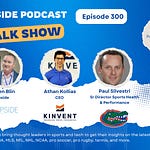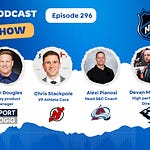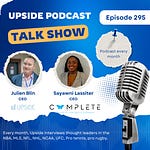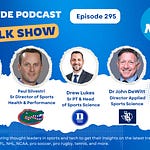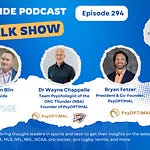This week we had the honor to interview again a group of sports performance experts.
Dr Bill Burgos an experienced NBA S&C coach, and adjunct professor at 2 universities: Mississippi state and Austin Peay State university.
Alexi Pianosi, S&C coach for the Pittsburgh Penguins (NHL).
Pierre Barrieu, an experienced high performance director in the MLS (LA Galaxy, LAFC, Toronto FC, NY Red Bulls, etc.), Premier League (Leeds United FC) and FIFA expert.
Adam Quigley, an experienced athletic trainer in the MLS (LA Galaxy), NFL (Saints) & US Soccer national teams.
📝Show Notes: Through this interview, we touched on some of the latest studies on the usage of wearables in elite sports. Then we talked about ChatGPT and generative AI in sports. We also discussed the emergence of robotics in pro sports. Lastly we talked about issues around stability in the world of elite sports.
🚀Best Quotes: Here are some of the key discussion points and best quotes from our conversation with Pierre, Bill, Alexi and Adam:
On a recent NCAA study that showed that 30% of the teams surveyed were not using the wearables that they bought due to various reasons (e.g. lack of accurate data, does not fit into the workflow..):
Pierre Barrieu:
“I've been confronted to these situation many times where you arrive into new teams and you inherit a bunch of technologies that have been used by previous coaches and at the end of the day, then you have what I can describe a trap of technology where a lot of them overlap with each other”.
“The low usage of wearables is also a byproduct of the last topic you mentioned, Julien, which is the stability in elite. The turnover with the staff in elite sports is a big reason why you have technologies in teams that end up not being used”.
“The other reason could be linked to a purely commercial standpoint, when you deal with all these contracts (associated with wearable products), these contracts are not one year contracts (..) If one technology becomes obsolete and you're still stuck in a contract, and I'm trying to put reason behind that 70%-30 (..) It could be as simple as the fact that the contract with this wearable product is still going on. And it happens more than you think”.
Alexi Pianosi:
“So I think that from what Pierre said, not understanding the reasons why you're wearing (wearables) and not articulating the problem that you have, whether it's an individual problem, a team problem, or an organizational problem, and then adopting that technology as a solution to that problem, and then using the data you collect from that piece of technology or that wearable to answer that problem, is critical”.
“If you really, truly have a problem and that technology is going be the answer to your problem, I think you're much more likely to use that data and then continue to use that wearable product (…) I think you're more likely to see those wearable adoption numbers creep above 70% up into the hundred percentile range when people can consistently answer and solve problems with that technology”.
Dr Bill Burgos:
“I've seen it where I've been on a team where we've actually shared a lot of information from wearable data, and we kept being consistent with the information, so the usage was always there”.
“But then I've been on teams where we didn't share the information as much and then the wearable usage started to fade away. They're like, why am I wearing this if I'm not getting anything out of it? So I think it's up to the practitioner at that point to make sure that their information is being shared”.
Adam Quigley:
“It's overall a combination of, I'd say, intention based utilization. You need someone to manage wearables and observe, analyze and implement them, but then you also need the environment to be receptive to the information”.
“So if we have some wearable technologies that, let's say, a football coach doesn't necessarily have a great educational background on how to use GPS monitoring, and then you're trying to force this down to someone's throat that doesn't fully understand it, it does not work”.
On ChatGPT, Generate AI and AI tools in general:
Alexi Pianosi:
“I should say that I have very little knowledge about ChatGPT and specifically the AI space, but it seems that that kind of technology's greatest strength could also be its greatest weakness. It gives you unbiased appraisal of trends and information on what you might not be seeing”.
“But then it also might fail to, and anyone who's worked in a professional sports environment knows that the context changes so often and how a coach feels, how a player feels, how the team's performing, how this guy's performing changes on a day-to-day basis, and it might not be able to incorporate that context, but it could give you an unbiased view of some things that maybe you’ve overlooked (..) I think we're pretty early in that space, so we'll have to see how that unravels in the professional sports environment”.
Dr Bill Burgos:
“We're trying to collect all this data, all this information so they can help make decisions for us. So it can give us time and we can start seeing these trends. So I think it's important, but it still has to be managed correctly. Basically, it all boils down to the user as well, in terms of the data that's being collected because whatever AI is going to spit out, it has to make sense”.
Adam Quigley:
“I think it's going to take very clear conversations around AI and then a very clear goal driven question or input into the AI system (…) And even in the performance entertainment space, we will utilize AI as a different variable. And if it works in our favor, we'll lean on it. And if it goes against what we want to do, then we'll say, I must have gotten this one wrong, and we go from there”.
“I do think that, as Bill summarized it, AI will end up taking the emotion out of the decision making if we put in all of this data to be analyzed and spit out with an X, Y, or Z as a result. And that way we can remove the emotion, make the decision, and then add in the context of the environment and implement from there”.
On the emergence of robotic technologies in elite sports:
Adam Quigley:
“As far as I know, we've been using robots for machinery in sport. For example we have the soccer ball shooter thing, or for a football pun robot that shoots it out. That's its own robot. And now if we could calculate something to help the system be a bit more reactive to the real environment of sport, that could be helpful”.
“As far as medical and performance teams, if we can continue using machinery and technology to find objective data and provide objective data measures in sporting environments, then it will really help”.
Alexi Pianosi:
“I could see, similar to Bill, a unique example, where a goal tender in hockey, who wants to work on taking shots through traffic, having to fight around screens and he/she wants high velocity shots coming in, but you don't want your own players potentially standing in the way and getting hit in the foot and breaking a foot or something like that”.
“So maybe there's an application where those robots in the future could be the ones who are providing gold tender screens and moving back and forth, something like that. And you're not putting your own players at risk. So there could be applications for it (…) So I think it's an exciting field and how that interacts with sports, but I believe it is still a way away”.
Dr Bill Burgos:
“Every time when I was with a team, every city I went to, especially when I went to a city like Boston, I would try to go to the labs (e.g. MIT) and try to talk to these engineers because engineers need people like us because we're in it daily. We understand what's needed, we have a Wishlist of things. And for them, they have a device that's cool, but they don't know how it could apply to our day to day. And so, I've seen a lo of cool technologies. For example I was just reading about this thing called the Alter Ego”.
“It is a little device that connects to you body and basically knows how you think. It'll type in the stuff for you and you could Google things just by thinking. It was really interesting (…) And so for me, as a practitioner, I always try to think of all the ways where I could I use those types of new devices.”
Pierre Barrieu:
“I don't know if I will see it in my lifetime, or at least in my professional lifetime, but I can see so many applications for robotics. Currently we use the dummies. So I could see a future where you could program dummies with the characteristics of the opponent on set pieces”.
“We already have some mechanical walls that can jump but you could have robots too. We can jump, reproducing what the opponent does. It is not a big problem, but it's one of the challenges (…) I could imagine a future where you would have four or five robots and where you could program the opponents’ movement patterns and what they do tactically and synchronize them in a way that can exactly reproduce what you know a team does”.
On the level of instability in elite sports and how to cope with it:
Dr Bill Burgos:
“When I started getting into pro sports, I understood that it wasn't really stable, especially when I became president of the NBA Strength Coach Association. I saw a high turnover of strength coaches. And at that time in the CBA, it didn't state that a strength coach had to be hired by a team (…) So now it's required for each team to have one. So that was our way of having some kind of stability”.
”For me personally, I also try to keep myself occupied with other things.
But those things didn't take me away from my current position. And one of them was teaching (..)And so teaching for me was a win-win situation because whatever I was teaching is what I was doing, and anything that I was trying to research I was actually applying it to my current job. So I was double dipping per se. But then that helped me when I decided to leave the NBA last season. I was able to basically pick up more classes with no concerns”.
“I also always made sure to create a great relationship with the players, the staff, and the coaches. It was never about me. And so I think that really helped me in terms of staying within a league that was well within a profession that was unstable but I always made sure that I was prepared for the transition”.
“I know one book that helped me a lot especially on the things they don't teach you at Harvard Business School. And one of the things they talked about in the book was how to negotiate contracts (…) It helped me a lot in terms of contract negotiation and I always had a long-term deals with NBA teams. And I always got what I asked for and then some”.
“And lastly something that also helped me was that I always made sure to have a place that I could call home despite all the travel I had to do”.
Alexi Pianosi:
“I'll go quickly because I've been fortunate there. I've worked for our organization, the Penguins, for the first six years of my career, and I've actually had the same head coach under all six of those years. We've had some other changes, throughout the organization, so there's definitely been some turnover but I haven't yet experienced the big shift of having a head coach leave”.
“So I think I can speak to how unstable it can be on a daily basis in pro sports, and that you have to both accept that, but also you need to understand, and appreciate your role in trying to provide stability in a world that's not stable”.
Pierre Barrieu:
“Two weeks ago I was coaching in the Premier League , and now I'm talking to you guys from my home in France, so when it comes to talking about stability, you have to accept it. And I did when I decided to move from Toronto, where I was in a top department in a top club (Toronto FC) in the MLS with stability and vision”.
“And the main byproduct and the main risk I was taking by going to the Premier League was being in the situation where if you don't win three, four weeks in a row, all of a sudden, because in our sport there's promotion and relegation, which is a big difference compared to the majority of American sports, the deciders are deciding that it's getting a little too close to losing a massive amount of money. If the team goes down and they decide to make a coaching change, knowing that this time, my contract with the head coach will be impacted, there will be consequences for me. And this leads me to my next point”.
“I've been chasing the dream of having a performance department that belongs to a club that is stable with experts in their field developing techniques, best practices, and no matter who the coach was, and I think I've reached that with the LA Galaxy. But eventually no matter how you twist it, you are always at the mercy of a coach, number one, because to be efficient in what you do, you have to be aligned with the head coaches and, and make sure that you have room to do what you can do for him the best way you can”.
“So having been a victim myself where the head coach will want to come to the club only if they come with 6, 7, 8, 10, 12 people in football at a time, I came to realize that. And again, I've been a victim of it, but I also understand why they do it (..) I think the MLS is starting to resemble a little bit what the rest of the leagues are around the world because the turnover is not faster, even if there's no relegation, but again, when you arrive in a club, your time is counting from the second you arrive because you have to have results”.
Adam Quigley:
“Some athletes are beginning to have their own private therapists or private athletic trainers, performance coaches outside the team environment, which I think, is significantly more stable because if the athlete has a bad game or if the team loses or head coach gets fired, you're still tied into some type of positive scenario, hopefully”.
“But that's part of the game that we play when we take a job within a sports setting (…) In the back of our mindset being in professional sports, that is up in the air and we end up having a good conversation with a significant other family, friends, or whomever is part of the decision process that we've made”.
You may also like:
🔥 Upside Chat: Dave Hancock, CEO, Apollo (Leading Athlete Management Systems (AMS) vendor)
🔥 Upside Chat: Dr Andy Barr, Consultant, Brooklyn Nets (NBA) & Quantum Performance Founder
🔥 Upside Chat: Ismael Fernandez, ThermoHuman CEO
🔥Upside: AMS Ecosystem Analysis: Key Trends, Vendors and Recommendations to Teams
💦Upside Analysis: The sweat and heat sensing market (Key Trends, Vendors)




